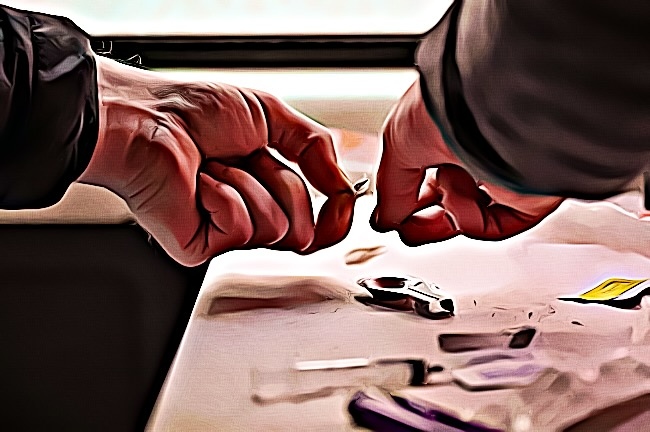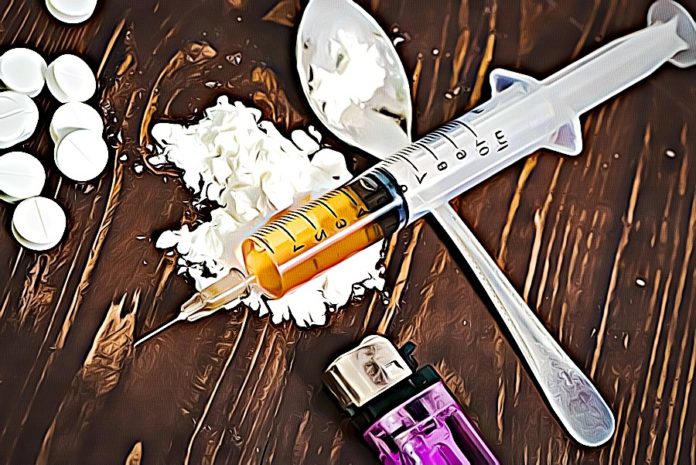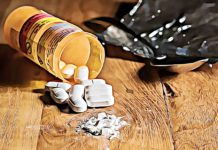An opioid narcotic with a significant potential for addiction, heroin is generated from morphine, which is present in some types of the poppy plant. Poppies thrive in warm, dry areas like South America, Mexico, and Southern Asia.
Typically, heroin is offered for sale as a white, brown, or sticky black tar. To provide those who sell it more products and increase their profit, it is frequently blended, or “cut,” with other ingredients like wheat, sugar, powdered milk, painkillers, starch, or quinine.
As fentanyl has been added to heroin more frequently, the strength and overdose danger has increased.
Heroin’s street names include:
- Brown sugar
- China white
- Dope
- H
- Horse
- Junk
- Skag
- Smack
- White horse
What Does Heroin Look Like?
Black Tar Heroin
Contrary to the drug’s powder form, black tar heroin is dark brown or black and has a tar-like, sticky feel from the poor processing method. Depending on the chemicals added during processing to reduce the purity of the finished product, the color may change. You may smoke or melt it and inject it right into your veins.
A relatively small portion of black tar heroin, often produced in Mexico, is pure heroin. However, it is cheaper than other types of heroin since it is quicker and simpler to make.
White Heroin
The purest form of heroin is white (diamorphine hydrochloride). However, it is frequently mixed with other drugs, greatly lowering its purity.
Because of the various chemicals that may have been used to process it, white heroin can be tricky to spot because it might resemble pink, brown, beige, or off-white. Because it needs to burn and smoke at a considerably greater temperature, it is typically injected or snorted.
Brown Heroin
Because brown heroin is less refined than white heroin, it isn’t as pure or powerful.
It is created during the first phase of the drug’s purification. Consequently, it is less expensive and easier to make than white heroin. Because brown heroin doesn’t dissolve properly, it is typically smoked.
Asian Heroin
Heroin from Southeast Asia is often white, powdered, and very water-soluble. Southwest Asian heroin often comes from a coarse, dark powder that dissolves poorly in water. Again, the materials used to cut the heroin before it is sold affect its hue.
What Are the Statistics on Heroin?
In 2007, heroin consumption in the U.S. began to increase again after years of decline. The increased accessibility of the substance contributes to the high demand. In addition, the opioid epidemic led to an increase in the use of heroin.
Pharmaceutical firms began exaggerating the risks of addiction to prescription opioids like hydrocodone and oxycodone in the 1990s. Patients received these prescriptions from numerous doctors, many of whom developed addictions.
People who become dependent on prescription opiates frequently transition to heroin use.
Opioids include heroin. However, heroin is more widely available and less expensive than prescription opioids.
Due to the increase in heroin use, more people have passed away from overdoses. In 2014, the number of overdose deaths more than doubled compared to 2010; from 2002 to 2016, heroin overdose deaths increased by 533%.
According to SAMHSA, since 2002, there has been a 135% increase in the number of people using heroin, from 404,000 to 948,000 in 2016.
However, the number of heroin users increased slightly between 2015 and 2016, indicating stabilization in the number of persons beginning to use heroin.
Officials from the Drug Enforcement Administration (DEA) think that these variables are to blame for the spike in heroin overdose deaths:
Because modern heroin is more affordable and frequently purer, unintentional overdoses occur.
- Younger, untried individuals are experimenting with heroin.
- In some markets, heroin is laced with toxic drugs like fentanyl, an even stronger narcotic painkiller than heroin.
- Former heroin users who relapse don’t possess the same tolerance as before.
- Many patients who become dependent on prescription opioids move to heroin. According to official statistics, nearly 80% of Americans who use heroin claim to have initially abused prescription opioids.
What Are the Indications of Heroin Use?
Although it could be challenging to tell if a friend or loved one is using heroin, there are physical and behavioral markers that could be helpful. The visible symptoms include:
- Flushed skin
- Decayed teeth
- Hand, wrist, or arm track markings (wearing long sleeves to cover marks)
- Poor personal grooming
- Rattle or sores
- Runny nose
- Scratching
- Slovene speech
- Sleepiness or drowsiness
- Sweating
- Vomiting
- Weight reduction
The following behaviors could indicate heroin use:
- Going missing for protracted periods
- Lying
- Financial difficulties
- Skipping work, school, or other obligations
- Mood changes (unexplained highs and lows)
- Theft of money
- Absence of friends and social interactions
A person possesses heroin paraphernalia, such as burnt spoons, tiny baggies with white powder or black/brown residue inside, glass pipes, syringes, burnt aluminum foil, and straws or empty pens, is another indication that they are using the drug.
What Are The Different Ways Heroin Is Used?
Heroin is injected, sniffed, snorted, or smoked. Speedballing is the term for the practice of combining heroin with crack cocaine.

What Consequences Does Heroin Have?
Heroin enters the brain fast and binds to opioid receptors on cells in numerous areas of the brain, including those responsible for controlling heart rate, breathing, and sleep cycles and those involved in pain and pleasure perception.
Temporary Effects
Heroin users claim to experience a “rush” (a surge of pleasure or euphoria). However, there are more widespread impacts, such as:
- Being “on the nod,” an alternating state of consciousness and unconsciousness
- Dizziness and vomiting
- Dry mouth
- Feeling sluggish in the arms and legs
- Impairment of mental clarity
- Intense itching
- Warmth on the skin’s surface
What Are the Long-Term Impacts of Addiction?
Long-term heroin users may experience the following side effects:
- Bloating and stomach cramps
- Collapsed veins in drug-injecting users
- Damaged nasal tissue in those who snort or sniff it
- Hepatitis and renal disease
- Infected heart valves and lining
- Infections (swollen tissue filled with pus)
- Insomnia
- Lung problems, such as pneumonia
- Male sexual dysfunction
- Psychological conditions including depression and antisocial personality disorder
- Women’s irregular menstrual cycles
Additional Potential Impacts
Heroin frequently contains additives that might clog blood vessels in the lungs, liver, kidneys, or brain, resulting in long-term harm. Examples of these additions include sugar, starch, and powdered milk.
Additionally, drug usage impairs judgment and sharing drug injection equipment raises the risk of developing infectious diseases like HIV and hepatitis (see “Injection Drug Use, HIV, and Hepatitis”).
Can You Get Addicted to Heroin?
Heroin has a high rate of addiction. Regular heroin users frequently acquire a tolerance to the drug, requiring higher and more frequent dosages to get the desired results.
Drug use persists and produces problems, such as health issues and an inability to fulfill work, school, or family obligations. It is called a substance use disorder (SUD). Addiction is the most severe form of a SUD, ranging from mild to severe.
Is It Possible To Overdose On Heroin?
Yes, a heroin overdose is possible. People who consume enough heroin to cause a life-threatening reaction or death have overdosed. Overdoses on heroin have surged recently.
People who overdose on heroin frequently experience slowed or stopped respiration. This may result in hypoxia, a condition when there is a reduction in the amount of oxygen reaching the brain. Hypoxia can cause unconsciousness, permanent brain damage, and impacts on short- and long-term mental and neurological systems.
How to Recover From Heroin Addiction?
The good news is that our heroin rehab centers provide three high-quality treatment alternatives to get you on the road to addiction recovery if you’re asking how to stop heroin addiction. It has been demonstrated that behavioral therapy’s vast array of techniques efficiently treats heroin addiction.
A few examples of behavioral therapies are leadership development, yoga, progressive relaxation, meditation, art and music therapy, relapse prevention, and many others. When combined with medicine, behavioral therapies are most helpful.
Rehab centers and associations organize support groups for people who all have heroin addictions. In addition, local addiction centers encourage one another in dealing with the problems associated with heroin addiction.
Conclusion
Do not wait and hope that a friend or family member will stop taking heroin. React immediately. The sooner someone receives assistance, the better. Heroin addiction is treatable. To find assistance close to you, get in touch with a drug rehabilitation center.
Source: https://medlineplus.gov/heroin.html
















